"Fancy Cakes"
May 07, 2009 - Volume 1 - Issue 4
|
|
|
|
|
|
Cake = Party, Party = Cake
|
A
special occasion almost always requires a cake - birthdays, weddings,
graduations, retirements - the celebration would seem incomplete
without one. There's a whole set of rituals and social etiquette
surrounding "the cake."  Songs
must be sung, flames must be lit, cutting carefully choreographed, and
photos flashed all the while to memorialize the moment. So is the
converse true? Does the presence of a cake mean the occasion is
special? We say, "Yes!" Making your own cake is easier than you think
and the results are so much more rewarding than the alternative. In
this issue we'll present some essential techniques for making delicious
cakes that live up to the expected standard, and riff on some fun
variations in the cake family - cupcakes and molded cakes. We finish
with a review of a brand-new cookbook that will inspire your "inner
baker," and three recipes from that book that will have you craving an
occasion just for the cake! Songs
must be sung, flames must be lit, cutting carefully choreographed, and
photos flashed all the while to memorialize the moment. So is the
converse true? Does the presence of a cake mean the occasion is
special? We say, "Yes!" Making your own cake is easier than you think
and the results are so much more rewarding than the alternative. In
this issue we'll present some essential techniques for making delicious
cakes that live up to the expected standard, and riff on some fun
variations in the cake family - cupcakes and molded cakes. We finish
with a review of a brand-new cookbook that will inspire your "inner
baker," and three recipes from that book that will have you craving an
occasion just for the cake!
|
First Monday Event - June 1st
|
 Join us for another
"First Monday" Event"
On June 1st from 4:00 - 7:00pm, we will be demonstrating great ideas and tips for the best part of summer --
Backyard Entertaining! Demonstrations will be held at 4:15pm, 5:15pm, and 6:00pm.
Backyard Entertaining!
Monday, June 1st
4:00 pm - 7:00 pm
Enjoy a 20% discount all during the event.
|
|
|
|
May 1st-16th Specials and Discounts!
|
Three Ways to Save BIG!
(1) Cake Pans and Cupcake Pans 20% off!
(2) Purchase 3 bottles of Decorating Sugars or Sprinkles, receive 1 of equal or lesser value free!
(3) Remember "First Mondays" from 4pm - 7pm, 20% off regularly-price merchandise! |
Essential Cake Techniques
|
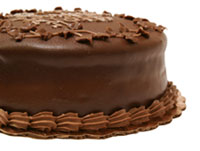 Some manufacturers of boxed cake mixes would have you believe that
making a cake is difficult. Not so! With a few key techniques your
baking repertoire can be expanded and the possibilities unleashed -
there's a large world outside of the box! Baking a cake turns you into
a bit of a kitchen chemist; combining ingredients in a certain sequence
and manner takes advantage of natural chemical reactions. Understanding
a little about what's going on will help you bake your best cake ever! Some manufacturers of boxed cake mixes would have you believe that
making a cake is difficult. Not so! With a few key techniques your
baking repertoire can be expanded and the possibilities unleashed -
there's a large world outside of the box! Baking a cake turns you into
a bit of a kitchen chemist; combining ingredients in a certain sequence
and manner takes advantage of natural chemical reactions. Understanding
a little about what's going on will help you bake your best cake ever!
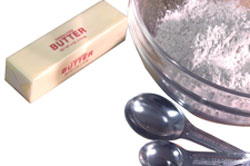 Measuring the Ingredients
- Improvisation in the kitchen is where the fun happens. However, when
baking there are certain rules and ratios to be followed so that the
chemistry of the recipe works well. Measuring ingredients accurately
is one of those rules that produces the desired results. Use dry
measuring cups for dry ingredients, and liquid measuring cups for
liquid ingredients. Choose high-quality measuring spoons that are
accurate; equipment testers report finding up to 25% inaccuracy with
some kitchen tools. Fluff your flour with a fork, then spoon it into
your measuring cup. Never pack flour, nor tap the cup so that it
settles. The only dry ingredient that is packed when measured is brown
sugar. Measuring the Ingredients
- Improvisation in the kitchen is where the fun happens. However, when
baking there are certain rules and ratios to be followed so that the
chemistry of the recipe works well. Measuring ingredients accurately
is one of those rules that produces the desired results. Use dry
measuring cups for dry ingredients, and liquid measuring cups for
liquid ingredients. Choose high-quality measuring spoons that are
accurate; equipment testers report finding up to 25% inaccuracy with
some kitchen tools. Fluff your flour with a fork, then spoon it into
your measuring cup. Never pack flour, nor tap the cup so that it
settles. The only dry ingredient that is packed when measured is brown
sugar.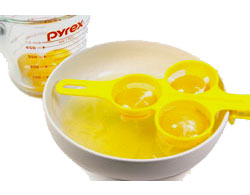
Egg Power
- Eggs are the golden not-so-secret ingredient for cakes. Eggs provide
protein strands that create the cake's structure when baked. Whipped
eggs expertly hold air bubbles that give the cake its airy texture.
Always use room temperature eggs when baking; the temperature relaxes
the protein strands making them more available when constructing the
batter. Some cake batters call for whole eggs, others call for
separating the yolks and whites. When separating eggs, take care; the
smallest bit of egg yolk will keep egg whites from whipping up to their
full potential.
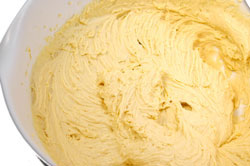 Batter Up
- Cake batters vary in composition. Generally, liquid ingredients are
assembled, and dry ingredients added gradually. Stir all dry
ingredients together well unless otherwise instructed. Dry ingredients
may be sifted through a sieve as they are being added to the liquid to
avoid clumps in the batter. Unlike muffins or pie crust where we're
urged to keep mixing to a minimum, cake batters like to be mixed. A
good cake recipe will specify how long to beat the batter at the
various stages. Don't shortcut the mixing times - a lot is happening. Batter Up
- Cake batters vary in composition. Generally, liquid ingredients are
assembled, and dry ingredients added gradually. Stir all dry
ingredients together well unless otherwise instructed. Dry ingredients
may be sifted through a sieve as they are being added to the liquid to
avoid clumps in the batter. Unlike muffins or pie crust where we're
urged to keep mixing to a minimum, cake batters like to be mixed. A
good cake recipe will specify how long to beat the batter at the
various stages. Don't shortcut the mixing times - a lot is happening. 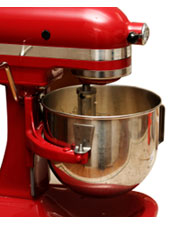 The
necessary chemical reactions take time, and the all-important air is
being incorporated during those minutes of mixing. We love our mixer
that has the elapsed mixing time noted right on the appliance. The
necessary chemical reactions take time, and the all-important air is
being incorporated during those minutes of mixing. We love our mixer
that has the elapsed mixing time noted right on the appliance.
Adding Air
- Incorporating air into the batter and trapping it in the baking
process creates the cake's texture. A fine, even texture of tiny,
trapped bubbles is the goal when cake-making. Recipes that use baking
powder generate some of the bubbles through a chemical reaction that
releases air as the powder meets the liquid. Air is also mechanically
incorporated into the batter during the beating process. Once the
beating is completed, pour the batter into waiting pans and bake
immediately. Do not allow the batter to stand in the mixing bowl;
those hard-won bubbles will disappear and you'll have a flat cake!
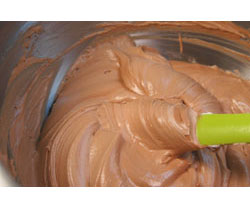 Learn How to Fold
- A great baking technique to master is folding. When maximum air is
called for, egg whites are often whipped separately to a soft peak
stage. The egg whites are then added to the cake batter very carefully.
We like to take a small portion of the egg whites and add it to the
waiting batter to lighten it first. Then, adding one third of the egg
whites at a time, draw a rubber spatula through the center of the
batter all of the way to the bottom of the bowl. Lift the spatula
allowing the whites and batter to fall gently on the top. Turn the bowl
slightly and repeat the reaching down and lifting up. Continue this
gentle motion just until no white streaks remain. Work slowly and
preserve those air bubbles! Learn How to Fold
- A great baking technique to master is folding. When maximum air is
called for, egg whites are often whipped separately to a soft peak
stage. The egg whites are then added to the cake batter very carefully.
We like to take a small portion of the egg whites and add it to the
waiting batter to lighten it first. Then, adding one third of the egg
whites at a time, draw a rubber spatula through the center of the
batter all of the way to the bottom of the bowl. Lift the spatula
allowing the whites and batter to fall gently on the top. Turn the bowl
slightly and repeat the reaching down and lifting up. Continue this
gentle motion just until no white streaks remain. Work slowly and
preserve those air bubbles!
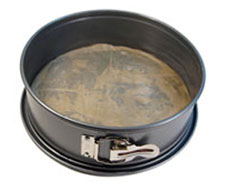 Pick the Right Pan
- Cake recipes are designed to fit a specifically-sized pan. Matching
your pan to the recipe will ensure that all of the batter will fit,
that there will be enough room for rising, and that the baking time is
accurate. Choose good quality pans that will not warp when exposed to
heat, nor dent or bend easily when stored. Pick the Right Pan
- Cake recipes are designed to fit a specifically-sized pan. Matching
your pan to the recipe will ensure that all of the batter will fit,
that there will be enough room for rising, and that the baking time is
accurate. Choose good quality pans that will not warp when exposed to
heat, nor dent or bend easily when stored.
Pan Prep
- Some proper preparation of the pan will save cursing later when
removing the baked cake. Again, a good recipe will recommend the best
pan prep. Instructions will vary from buttering or greasing the pan, to
greasing with a light dusting of flour, to inserting a layer of
parchment paper.
Baking Temperatures
- The chemistry of cake-making all comes together during the baking
process. Air expands when heated amplifying the power of the tiny
batter bubbles. The proteins in the batter are immortalized trapping
the air and forming the texture. Most cake baking is done in a medium
oven between 325°-350° F. Make sure your oven and racks are level. If
your oven has "hot spots" you may need to compensate by rotating pans
during baking. Ideally, to preserve consistency, the oven door stays
closed until it's time to test for doneness.
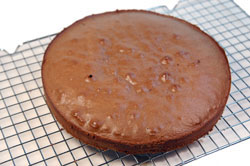 Testing for Doneness
- It seems like most cakes are dry and over-baked. We like to set our
timer for five minutes less than the recipe calls for and begin our
testing at that stage. A toothpick, cake tester, or thin-bladed knife
placed in the center of the cake should come out clean. Sometimes it's
ready at the early stage, sometimes precisely on the mark, and
sometimes 5-10 minutes later. If your pan differs from the recipe's
recommendation, the time of doneness will be impacted. Testing for Doneness
- It seems like most cakes are dry and over-baked. We like to set our
timer for five minutes less than the recipe calls for and begin our
testing at that stage. A toothpick, cake tester, or thin-bladed knife
placed in the center of the cake should come out clean. Sometimes it's
ready at the early stage, sometimes precisely on the mark, and
sometimes 5-10 minutes later. If your pan differs from the recipe's
recommendation, the time of doneness will be impacted.
Unmolding
- If your pan has been prepped well, removing the cake from the pan is
no problem. If necessary, run the back of a thin-bladed knife around
the sides of the pan. Place a cooling rack on top of the slightly
cooled cake pan and invert the two together. The cake pan may be lifted
off leaving the cake safely on the cooling rack. Use a second cooling
rack to re-invert if necessary. If your cake sticks to the bottom of
the pan, pay closer attention to the pan preparation step the next time
around.
|
|
Cupcake Crazy
|
Petite,
portable, and portion-controlled, cupcakes are enjoying a well-deserved
renaissance. There's a buzz about cupcakes that's generated a rash of
bakeries in larger cities that specialize in just 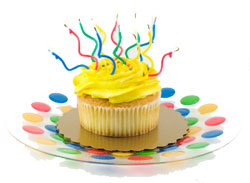 cupcakes. No
longer just a "kid-thing," cupcakes appeal to all generations just
because of their size and portability. Cupcakes hold just the right of
amount of self-indulgence without breaking the bank or the buttons, and
they don't require any utensils for serving or eating. cupcakes. No
longer just a "kid-thing," cupcakes appeal to all generations just
because of their size and portability. Cupcakes hold just the right of
amount of self-indulgence without breaking the bank or the buttons, and
they don't require any utensils for serving or eating.
The term
"cupcake" originated from the early baking traditions that used small
cups made of pottery to bake the sweet confections. These baking molds
predate muffin tins and were reported to be about the size of a teacup.
We love the whimsical British term for cupcakes, "fairy cakes."
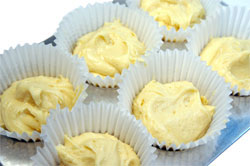 Cupcakes come in all sizes. Have some fun experimenting with different pans that yield perfectly portioned pieces: Cupcakes come in all sizes. Have some fun experimenting with different pans that yield perfectly portioned pieces:
- Traditional muffin pans
- Mini-muffin pans
- Tartlet Pans
- Muffin Top Pans
- Mini-Loaf Pans
- Individual mold pans
- Small ramekins
Cupcakes
often suffer from over-baking and dryness. To solve this, choose the
right recipe and monitor doneness diligently. Bake cupcakes up to a
month in advance and freeze until ready for icing and decorating.
Paper
liners for baking cupcakes eliminate any pan prep while keeping the
petite cakes from drying out afterwards. Some fun silicone cupcake
holders make for a lot of added fun. 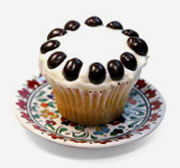
Decorating
cupcakes is a great way to spend time with little chefs and to express
your own creativity. Begin with a base layer of frosting applied with
the help of an offset spatula, a tool that is quite handy for this
task. Any icing appropriate for a cake is appropriate for cupcakes with
the exception of icings that are primarily whipped cream. Designs and
flourishes may be piped on with a simple decorator's kit, or fun shapes
molded from ready-made fondant. Sometimes simple toppings are all
that's needed: toasted nuts, coconut, fruit, colored sugars,
nonpareils, little candies, or chocolate shavings.
The cupcake
itself is just the beginning of the fun! We've seen cupcakes arranged
in tiers in lieu of wedding cakes, cupcake decorating contests, cupcake
haiku, cupcake blogs; it's endless and timeless!
|
Sculptures in Cake
|
Most of us are familiar with the classic Bundt cake pan. Originating from a 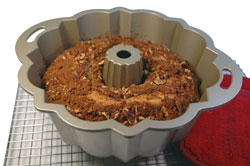 German tradition of kugelhopf,
(coffeecakes baked in a fluted ring pan), the modern day Bundt pan was
developed in the 1950's by H. David Dahlquist in Minneapolis, MN. Mr.
Dahlquist's company became the Nordic Ware company that is well-known
today for its quality bakeware. More than 50 million of the trademarked
Bundt pans are reported to have been sold. And, should you find
yourself in a food trivia contest, National Bundt Pan Day is November
15th! German tradition of kugelhopf,
(coffeecakes baked in a fluted ring pan), the modern day Bundt pan was
developed in the 1950's by H. David Dahlquist in Minneapolis, MN. Mr.
Dahlquist's company became the Nordic Ware company that is well-known
today for its quality bakeware. More than 50 million of the trademarked
Bundt pans are reported to have been sold. And, should you find
yourself in a food trivia contest, National Bundt Pan Day is November
15th!
Nordic Ware cake pans are constructed from heavy aluminum
that promotes even baking. The special surface provides great detail
and easy unmolding. 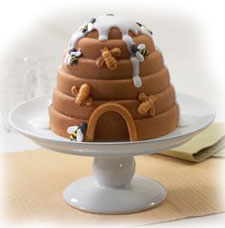 Bundt bakeware features large, single cake pans and
molds for individual cakes. Each Bundt
pan is sized by volume for easy matching to an appropriate recipe. At
their website, Nordic Ware provides some great tips for "How-To Bake the Perfect Bundt Cake." Bundt bakeware features large, single cake pans and
molds for individual cakes. Each Bundt
pan is sized by volume for easy matching to an appropriate recipe. At
their website, Nordic Ware provides some great tips for "How-To Bake the Perfect Bundt Cake."
From
their classic beginnings, the Nordic Ware people have unleashed their
creativity in the 21st century into a whole line of sculpted cake pans.
You can find a variety of molds that turn a simple cake into a
celebration. We like to think of these pans as "traditions in the
making." The sturdy pans last a lifetime and will be one of those
items that get passed on to future generations. Choose from different
seasonal motifs such as a bunny, a pumpkin, holiday trees, floral
designs, hearts, or even a beehive, and start your own family cake
tradition. |
Smart Cake-Making Tips
|
Tip #1: Did you forget to take
the butter out of the refrigerator to soften? Set the sticks upright on
the kitchen counter for maximum air circulation for about 30 minutes.
Meanwhile, you can prepare your baking pans, measure other ingredients,
etc. If you're very careful, a stick of butter can be softened on the
defrost cycle of your microwave in a mere five seconds.
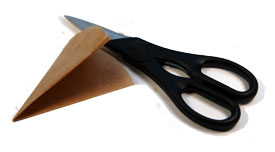 Tip #2:
Use a technique from grade school to prepare parchment paper for your
baking pans. For a round pan, fold a square of parchment paper in half,
half again, and once more - 8 layers of paper. With your kitchen
shears, (handily stored in your knife block), freehand cut an arc with
a radius equidistant from the folded point. Trim as necessary for a
final fit. Tip #2:
Use a technique from grade school to prepare parchment paper for your
baking pans. For a round pan, fold a square of parchment paper in half,
half again, and once more - 8 layers of paper. With your kitchen
shears, (handily stored in your knife block), freehand cut an arc with
a radius equidistant from the folded point. Trim as necessary for a
final fit.
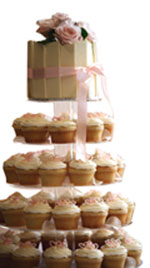
Tip #3:
To create a visually appealing presentation, display cakes and cupcakes
at different heights. A cake stand is the perfect pedestal for your
lovely baked creation. It not only elevates the cake, but the occasion
as well. A tiered serving plate is perfect for displaying and serving
a set of cupcakes.
Tip #4:
Transporting cakes and other baked goods can be a challenge. Give
yourself a fighting chance of getting your creation to its destination
by using specialized cake or cupcake transporters. The covered design
of transporters will keep your decorations safe and the cake moist and
fresh.
Tip #5: Decorate a batch of cupcakes in such way that when served together create a presentation design, similar to pieces of a puzzle.
|
Q & A's
|
 Q: My baking pans have a greasy residue on them. What is it and why can't I clean it off? Q: My baking pans have a greasy residue on them. What is it and why can't I clean it off?
A:
Many popular cooking sprays will leave a residue on your baking pans
that is nearly impossible to remove. To keep your pans looking like new
and baking well, we recommend using butter or oil to grease your pans.
For many applications, parchment paper or silicone mats will create a
non-stick baking surface. The only spray recommended by Nordic Ware for
use with their Bundt pans is Baker's Joy Non-Stick Spray which supplies
both flour and oil in the spray.

Q: What's the best way to cut one cake layer into two layers?
A:
Some layered cake recipes call for thin layers of cake where one baked
layer is cut in half. To obtain two equally thick layers, use a
long-bladed, serrated knife such as a bread knife. Score the outer
edge with the knife cutting no more than one half-inch deep. Once
scored all around, begin cutting deeper with the serrated knife turning
the layer gradually and using the scored line as a guide.
Q: What's the origin of the phrase "Let them eat cake!"
A:
This common phrase is most often attributed to Marie Antoinette from
the mid-18th century. When told that the French people had no bread to
eat due to a flour shortage and a complex pricing policy, she uttered
the remark. To our modern ear, the remark seems rather callous.
However, the French phrase is "Qu'ils mangent de la brioche,"
refers to a baked good that relied more on eggs and less on flour, and
would have been more available and nutritious to the peasantry.
Q: How do I keep crumbs from gathering during frosting?
A:
Tops of cakes have just a bit of crust that holds the cake surface
intact. The sides and bottoms, however, do not. Freeze the cake layers
just slightly before frosting. The outer frozen surface will make
spreading the frosting easy with less crumbling during frosting.
Q: What are "butterfly cakes?"
A:
This fanciful term comes from a 1950's tradition with cupcakes. To make
your own butterfly cakes, trim off the top of the cupcake, cut in half
and set aside. Scoop out some of the crumb from the cupcake base and
fill with fruit compote, whipped cream, or pudding. Place the two
halves in the filling at an angle to simulate butterfly wings.
|
Cookbook Review
|
The Modern Baker, Time-Saving Techniques for Breads, Tarts, Pies, Cakes, and Cookies by Nick Malgieri. Copyright 2008. Published by DK Publishing, New York, NY.
A 2009 Nominee for the prestigious IACP Cookbook Awards.
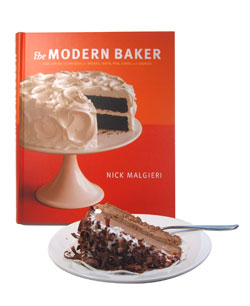 If
you're inspired to develop your "inner baker," this book is for you!
Mr. Malgieri has assembled the new primer for making baked goods at
home. The hefty book covers breads, tarts, pies, cakes, and cookies.
He's constructed his recipes in a step-by-step fashion that brings the
novice along, while retraining the expert baker in new techniques that
save time without compromising the ingredients or the results. As
Malgieri states, "this whole book is very technique oriented, with
explanations about the hows and whys . . . . " It's hard to beat
fresh-baked food, and nothing is fresher than those items made in your
own kitchen. Mr. Malgieri promotes taking a Zen-like attitude toward
baking - something to be enjoyed, the process savored, and the results
relished. Expertly photographed by Charles Schiller, the luscious
pictures are pure inspiration by themselves. We love a well
put-together book, and this one qualifies in content, design, and
published quality; it's obvious why this book has risen to the top tier
of the cookbook world. If
you're inspired to develop your "inner baker," this book is for you!
Mr. Malgieri has assembled the new primer for making baked goods at
home. The hefty book covers breads, tarts, pies, cakes, and cookies.
He's constructed his recipes in a step-by-step fashion that brings the
novice along, while retraining the expert baker in new techniques that
save time without compromising the ingredients or the results. As
Malgieri states, "this whole book is very technique oriented, with
explanations about the hows and whys . . . . " It's hard to beat
fresh-baked food, and nothing is fresher than those items made in your
own kitchen. Mr. Malgieri promotes taking a Zen-like attitude toward
baking - something to be enjoyed, the process savored, and the results
relished. Expertly photographed by Charles Schiller, the luscious
pictures are pure inspiration by themselves. We love a well
put-together book, and this one qualifies in content, design, and
published quality; it's obvious why this book has risen to the top tier
of the cookbook world.
|
Fancy Cake Recipes
|
Recipes excerpted from The Modern Baker by Nick Malgieri. Copyright 2008. Used by permission of DK Publishing, New York, NY. Used with permission. All rights
reserved.
Sour Cream Coffeecake
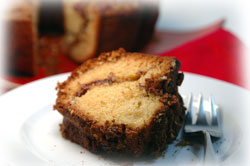 While
baking, the kitchen was redolent with the aromas of cinnamon and sugar
- we could hardly stand it! The result was a moist slice of coffeecake
that lived up to all of the anticipation. The cake unmolded without any
error - the sign of a good pan matched with a good recipe! Each bite
melted in our mouths. This recipe is quick, easy, and definitely in the
"keeper" file. While
baking, the kitchen was redolent with the aromas of cinnamon and sugar
- we could hardly stand it! The result was a moist slice of coffeecake
that lived up to all of the anticipation. The cake unmolded without any
error - the sign of a good pan matched with a good recipe! Each bite
melted in our mouths. This recipe is quick, easy, and definitely in the
"keeper" file.
Click here to view the recipe.
Click here for a printable version of the recipe.
Golden Cupcakes
 These
cupcakes had substance, not anything like the inferior cupcakes of
questionable character that we've become accustomed to. It's like
biting into a real peach! Moist from the sour cream, the petite cakes
domed perfectly providing a proper canvas for frosting and decorating.
They made several people instantly happy! These
cupcakes had substance, not anything like the inferior cupcakes of
questionable character that we've become accustomed to. It's like
biting into a real peach! Moist from the sour cream, the petite cakes
domed perfectly providing a proper canvas for frosting and decorating.
They made several people instantly happy!
Click here to view the recipe.
Click here for a printable version of the recipe.
Milk Chocolate Mousse Cake
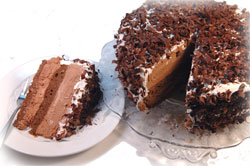 Ok,
this one is a little more complex, but oh, sooo worth it! It's really
two recipes combined into multiple layers of pure dessert nirvana. A
triple chocolate experience, two layers of cocoa génoise (cake) provide
the structure, two layers of chocolate mousse are interleaved, and the
entire masterpiece is slathered with whipped cream and generously
topped with chocolate curls. Thankfully, the process can be staged over
a couple of sessions in the kitchen and then completed well ahead of
any guests arriving. Ok,
this one is a little more complex, but oh, sooo worth it! It's really
two recipes combined into multiple layers of pure dessert nirvana. A
triple chocolate experience, two layers of cocoa génoise (cake) provide
the structure, two layers of chocolate mousse are interleaved, and the
entire masterpiece is slathered with whipped cream and generously
topped with chocolate curls. Thankfully, the process can be staged over
a couple of sessions in the kitchen and then completed well ahead of
any guests arriving.
.
Click here to view the recipe.
Click here for a printable version of the recipe.
|
 |
Enjoy making your cake and eating it too!
|
|
Lorraine, Katie, and all of the Staff at Beyond Pots and Pans
|
|
|
|
|